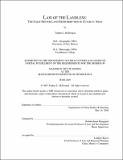| dc.contributor.advisor | Balakrishnan Rajagopal. | en_US |
| dc.contributor.author | McDougal, Topher L. (Topher Leinberger) | en_US |
| dc.contributor.other | Massachusetts Institute of Technology. Dept. of Urban Studies and Planning. | en_US |
| dc.date.accessioned | 2008-01-10T14:26:36Z | |
| dc.date.available | 2008-01-10T14:26:36Z | |
| dc.date.copyright | 2007 | en_US |
| dc.date.issued | 2007 | en_US |
| dc.identifier.uri | http://hdl.handle.net/1721.1/39853 | |
| dc.description | Thesis (M.C.P.)--Massachusetts Institute of Technology, Dept. of Urban Studies and Planning, 2007. | en_US |
| dc.description | This electronic version was submitted by the student author. The certified thesis is available in the Institute Archives and Special Collections. | en_US |
| dc.description | Includes bibliographical references (p. 107-110). | en_US |
| dc.description.abstract | This study examines how government's implementation of land reforms in Gujarat, India informs Dalit (i.e., 'Outcaste') activism for land redistribution. It takes as a case study the Navsarjan Trust (or simply Navsarjan), a non-profit group that advocates for Dalit land rights in Surendranagar district, Gujarat. I contend that the Dalit land movement has implicitly recognized a complex reality: the outcomes of state policy on the ground are the products of a struggle between competing caste interests located within a nested hierarchy of local government institutions. I argue that Navsarjan's strategy is to modify the strength of the links between levels in this nested game--oftentimes by allowing Dalit land appeals to bypass lower, less progressive levels of government in favor of higher ones--in order to produce favorable results for the Dalit land rights movement. This strategy explodes the myth of a monolithic, intransigent state, and portrays government rather as a framework that structures social struggle. Section 1 argues that land redistribution is seen by the Dalit activist movement as a means of verticalizing horizontal ethnic stratifications. In Section 2, I quantitatively analyze the role and effects of local government offices charged with the implementation of land reform legislation. | en_US |
| dc.description.abstract | (cont.) I argue that the hierarchy of local government constitutes a nested battleground, on which the interests of Dalits and the upper-castes vie for influence. In Section 3, I examine Navsarjan's tactics in the land redistribution movement. I argue that the organization's success is largely due to its dual role as both agitator and embedded bureaucratic facilitator within the government hierarchy. I then examine qualitative evidence that could complement (and point up shortcomings of) Section 2's quantitative analysis. I conclude by examining avenues for future research and making policy recommendations for Navsarjan and for the state. | en_US |
| dc.description.statementofresponsibility | by Topher L. McDougal. | en_US |
| dc.format.extent | 125 p. | en_US |
| dc.language.iso | eng | en_US |
| dc.publisher | Massachusetts Institute of Technology | en_US |
| dc.rights | M.I.T. theses are protected by copyright. They may be viewed from this source for any purpose, but reproduction or distribution in any format is prohibited without written permission. See provided URL for inquiries about permission. | en_US |
| dc.rights.uri | http://dspace.mit.edu/handle/1721.1/7582 | |
| dc.subject | Urban Studies and Planning. | en_US |
| dc.title | Law of the landless : the Dalit bid for land redistribution in Gujarat, India | en_US |
| dc.type | Thesis | en_US |
| dc.description.degree | M.C.P. | en_US |
| dc.contributor.department | Massachusetts Institute of Technology. Department of Urban Studies and Planning | |
| dc.identifier.oclc | 183205739 | en_US |

